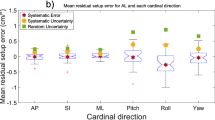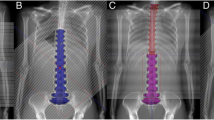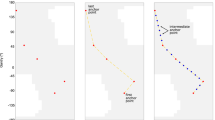Abstract
We investigated the influence of random spot positioning errors (SPEs) on dosimetric outcomes of robustly optimized intensity-modulated proton therapy (RB-IMPT) plans in craniospinal irradiation (CSI). Six patients with CSI treated using the RB-IMPT technique were selected. An in-house MATLAB code was used to simulate a random SPE of 1 mm in positive, negative, and both directions for 25%, 50%, and 75% of the total spot positions in the nominal plan. The percentage dose variation (ΔD%) in the six nominal and 54 error-introduced plans was evaluated using standard dose-volume indices, line dose difference, and 3D gamma analysis method. The introduction of a random SPE of 1 mm resulted in a reduction in D99%, D98%, and D95% of both CTVs and PTVs by < 2% compared with the corresponding nominal plans. However, this leads to an increase in D1% of the lens by up to 16.9%. The line dose in the junction region showed ΔD% < 2% for the brain and upper spine and < 4% for the upper and lower spine. The 3D gamma values for 3% at 3 mm and 2% at 2 mm were above 99% and 95%, respectively, in all 54 error-introduced plans. The worst decrease in gamma values was observed for 1% at 1 mm, with values ranging from 64 to 78% for all types of SPE. The RB-IMPT plan for CSI investigated in this study is robust enough for target coverage, even if there are random SPEs of 1 mm. However, this leads to an increase in the dose to the critical organ located close to the target.






Similar content being viewed by others
References
St. Clair WH, Adams JA, Bues M, et al. Advantage of protons compared to conventional X-ray or IMRT in the treatment of a pediatric patient with medulloblastoma. Int J Radiat Oncol Biol Phys. 2004;58:727–34.
Lee CT, Bilton SD, Famiglietti RM, et al. Treatment planning with protons for pediatric retinoblastoma, medulloblastoma, and pelvic sarcoma: how do protons compare with other conformal techniques? Int J Radiat Oncol Biol Phys. 2005;63:362–72.
Seravalli E, Bosman M, Lassen-Ramshad Y, et al. Dosimetric comparison of five different techniques for craniospinal irradiation across 15 European centers: analysis on behalf of the SIOP-E-BTG (radiotherapy working group). Acta Oncol. 2018;57:1240–9.
Ho ESQ, Barrett SA, Mullaney LM. A review of dosimetric and toxicity modeling of proton versus photon craniospinal irradiation for pediatrics medulloblastoma. Acta Oncol. 2017;56(8):1031–42.
Stoker JB, Grant J, Zhu XR, Pidikiti R, Mahajan A. Grosshans DR Intensity modulated proton therapy for craniospinal irradiation: organ-at-risk exposure and a low-gradient junctioning technique. Int J Radiat Oncol Biol Phys. 2014;1(90):637–44.
Farace P, Bizzocchi N, Righetto R, et al. Supine craniospinal irradiation in pediatric patients by proton pencil beam scanning. Radiother Oncol. 2017;123:112–8.
Lin H, Ding X, Kirk M, et al. Supine craniospinal irradiation using a proton pencil beam scanning technique without match line changes for field junctions. Radiat Oncol Biol. 2014;90:71–8.
Zaghian M, Cao W, Liu W, et al. Comparison of linear and non-linear programming approaches for “worst case dose” and “minmax” robust optimization of intensity-modulated proton therapy dose distributions. J Appl Clin Med Phys. 2017;18:15–25.
Fredriksson A. Minimax optimization for handling range and setup uncertainties in proton therapy. Med Phys. 2011;38(3):1672–84.
Yu J, Beltran CJ, Herman MG. Implication of spot position error on plan quality and patient safety in pencil-beam-scanning proton therapy. Med Phys. 2014;41(8):081706.
Peterson S, Polf J, Ciangaru G, Frank SJ, Bues M, Smith A. Variations in proton scanned beam dose delivery due to uncertainties in magnetic beam steering. Med Phys. 2009;36:3693–702.
Alshaikhi J, Doolan PJ, D’Souza D, Holloway SM, Amos RA, Royle G. Impact of varying planning parameters on proton pencil beam scanning dose distributions in four commercial treatment planning systems. Med Phys. 2019;46(3):1150–62.
Tasson A, Laack NN, Beltran C. Clinical implementation of robust optimization for craniospinal irradiation. Cancers (Basel). 2018;10(1):7.
Tommasino F, Widesott L, Fracchiolla F, Lorentini S, Righetto R, Algranati C, et al. Clinical implementation in proton therapy of multi-field optimization by a hybrid method combining conventional PTV with robust optimization. Phys Med Biol. 2020;65:045002.
Saini J, Maes D, Egan A, et al. Dosimetric evaluation of a commercial proton spot scanning Monte-Carlo dose algorithm: comparisons against measurements and simulations. Phys Med Biol. 2017;62:7659–81.
Low DA, Harms WB, Mutic S, Purdy JA. A technique for the quantitative evaluation of dose distributions. Med Phys. 1998;25:656–61.
Funding
No funding.
Author information
Authors and Affiliations
Corresponding author
Ethics declarations
Conflict of Interest
The author declares no conflicts of interest.
Ethical approval
All the procedures performed in studies involving human participants were in accordance with the ethical standards of the institutional and/or national research committee and with the 1964 Helsinki Declaration and its later amendments or comparable ethical standards.
Additional information
Publisher's Note
Springer Nature remains neutral with regard to jurisdictional claims in published maps and institutional affiliations.
About this article
Cite this article
Noufal, M.P., Sharma, S.D., Patro, K. et al. Impact of spot positional errors in robustly optimized intensity-modulated proton therapy plan of craniospinal irradiation. Radiol Phys Technol 14, 271–278 (2021). https://doi.org/10.1007/s12194-021-00625-3
Received:
Revised:
Accepted:
Published:
Issue Date:
DOI: https://doi.org/10.1007/s12194-021-00625-3




